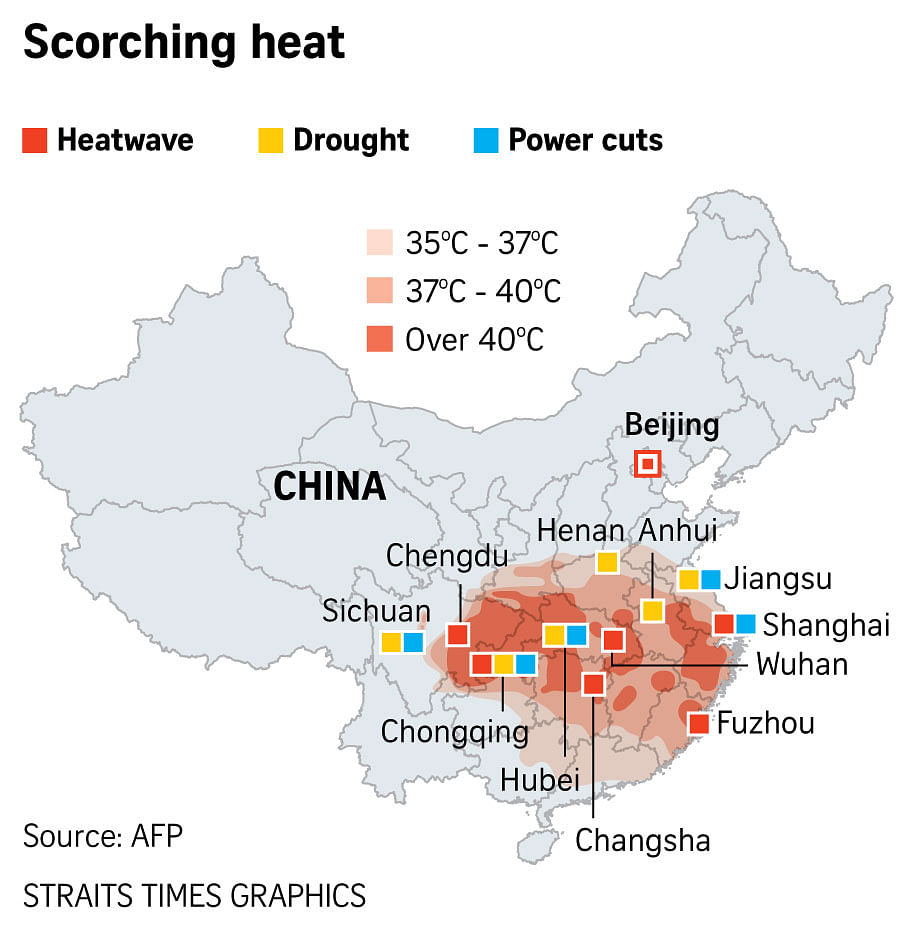BEIJING (BLOOMBERG) - China's top energy officials are calling for the addition of more power-generation capacity and cross-province grids as Sichuan grapples with a severe drought that's prompted outages and shut down key factories in the region.
The National Energy Administration acknowledged supply challenges caused by high temperatures and a lack of hydroelectricity generation in a statement reviewing its power system. The agency pledged to ensure a nationwide balance of supply and demand by 2025.
China will accelerate hydro and nuclear power projects, while pushing for more transmission lines across provinces and expanding renewable capacity such as wind and solar in the next few years, the agency said.
Sichuan, which relies on hydropower for 82 per cent of its power generation, is seeing its worst drought in more than a half century as temperatures have soared above 40 deg C. The province has activated its highest emergency response and ordered industrial production halts that impacted the supply of automobile parts and key materials.
The southwestern province is a major hub of production for polysilicon used in solar panels and lithium chemicals used in electric vehicle batteries, both of which had already seen prices skyrocket even before the drought because of strong energy transition demand.
About 5,000 to 7,000 tonnes of lithium production is impacted at the moment, and if disruptions continue for longer it may force cathode producers and eventually battery makers to scale back output, Rystad Energy analyst Susan Zou said in a Bloomberg Television interview.
"Even if there's no further extension of power cuts from Friday, lithium producers may not be able to immediately resume full operational rates," she said.
Sichuan is a power-exporting province, so it doesn't have the infrastructure to receive enough from other regions, BloombergNEF analyst Nannan Kou said in an interview with Bloomberg Television.
He said the province also lacks the coal capacity to cover the gap from the drop in hydro production.
"The situation is only going to get better when the weather conditions are eased," Kou said.
Temperatures in Sichuan are expected to remain high on Tuesday (Aug 23) and Wednesday before rain and cooler weather arrives from Thursday.

Shanghai’s iconic skyscrapers dimmed their exteriors on Monday as part of a two-day suspension, as the financial hub feels the spillover effects of an acute power shortage wreaking economic havoc thousands of kilometers away.
City authorities announced on Sunday that in order to manage electricity use, landscape lighting and advertising billboards would be shut down in areas along the Huangpu riverside including The Bund waterfront, as well as central Lujiazui – home to landmarks including the Oriental Pearl Tower and Shanghai Tower.
Sichuan province’s worst drought in more than a half century and a heat wave driving up air-conditioning demand are sapping hydropower generation and drying up reservoirs along the Yangtze River.
Shanghai receives some of its power via long-distance transmission lines from several Yangtze dams, including Xiangjiaba on the border of Sichuan and Yunnan provinces, and Three Gorges, the world’s largest power plant.

